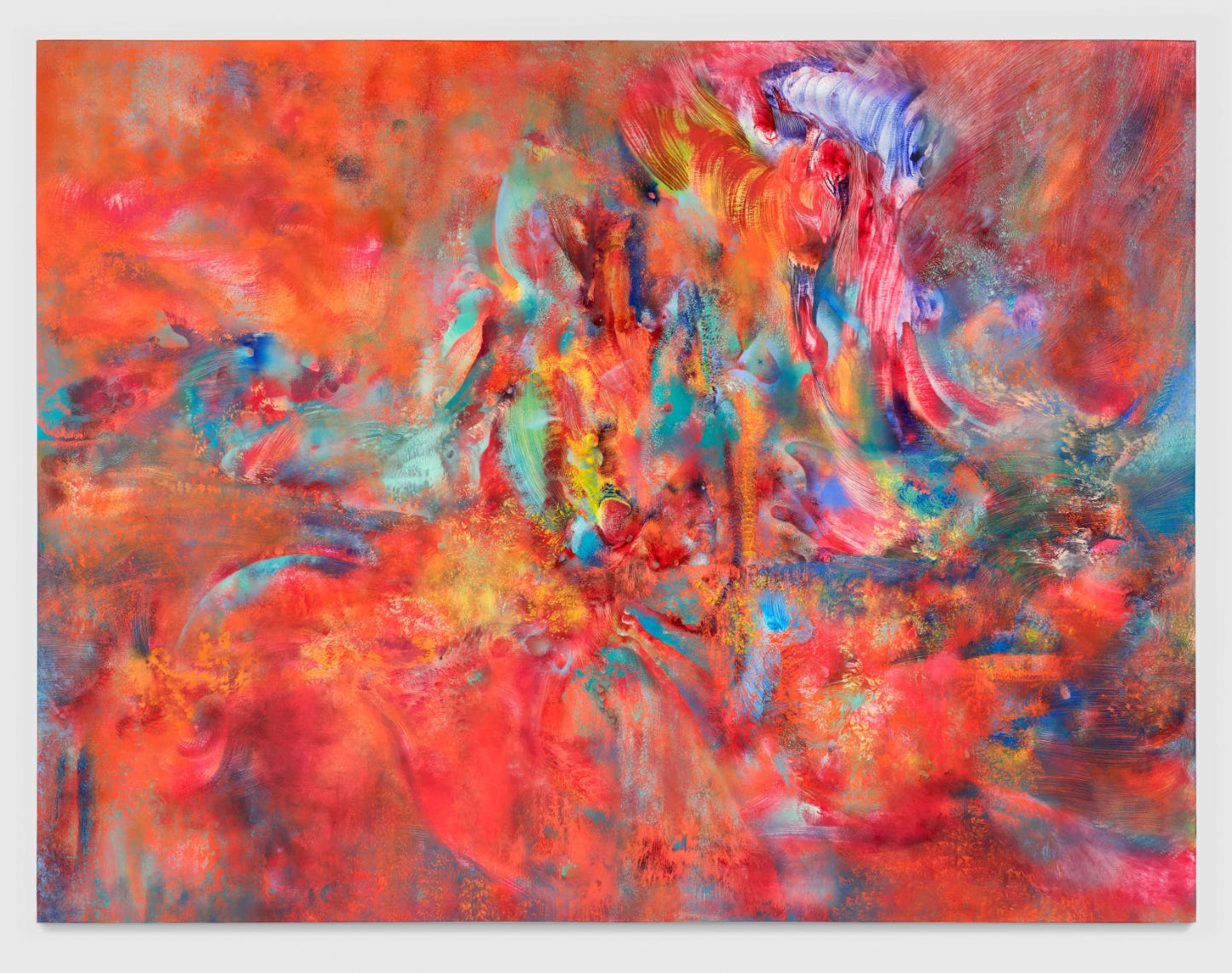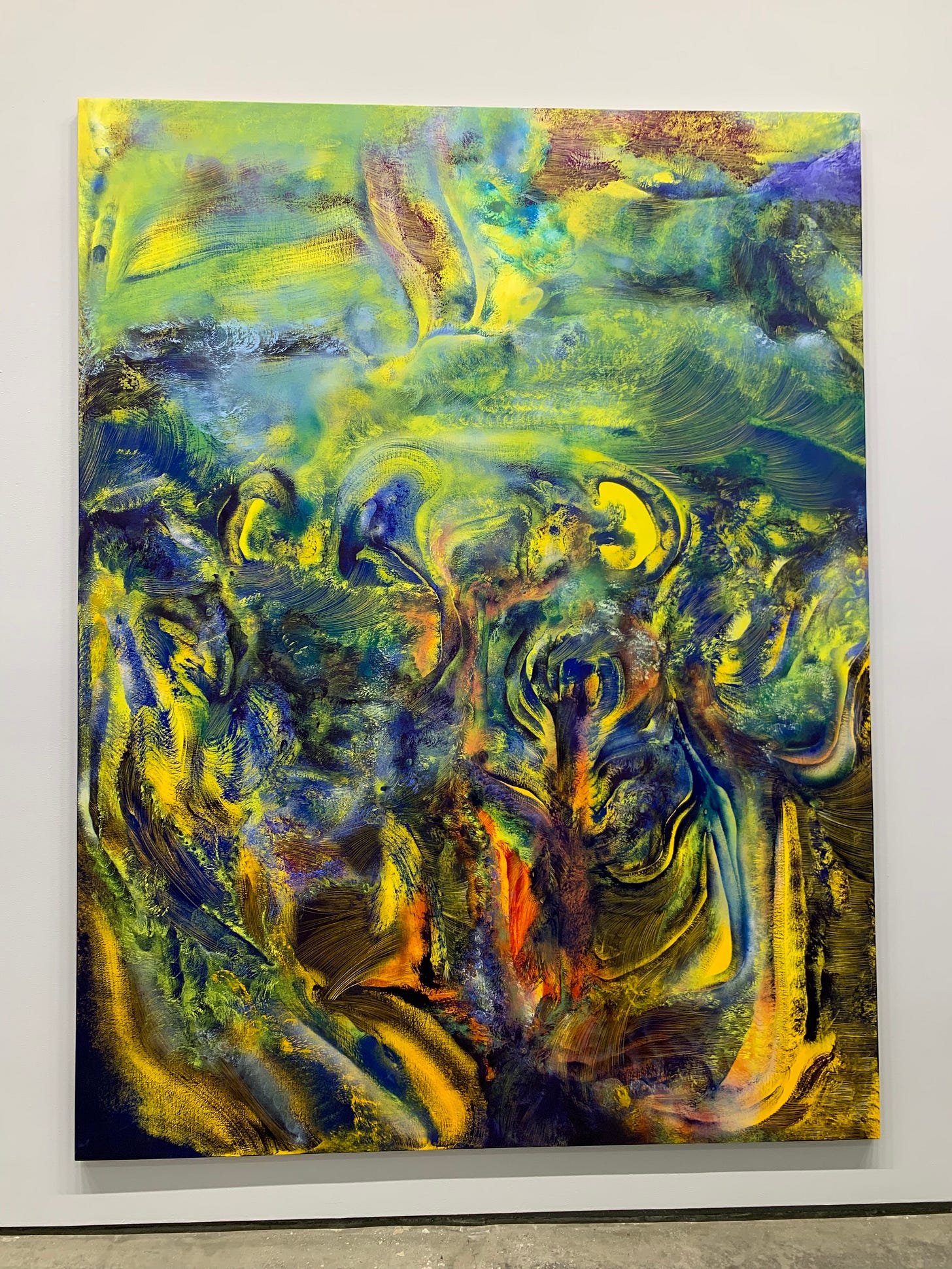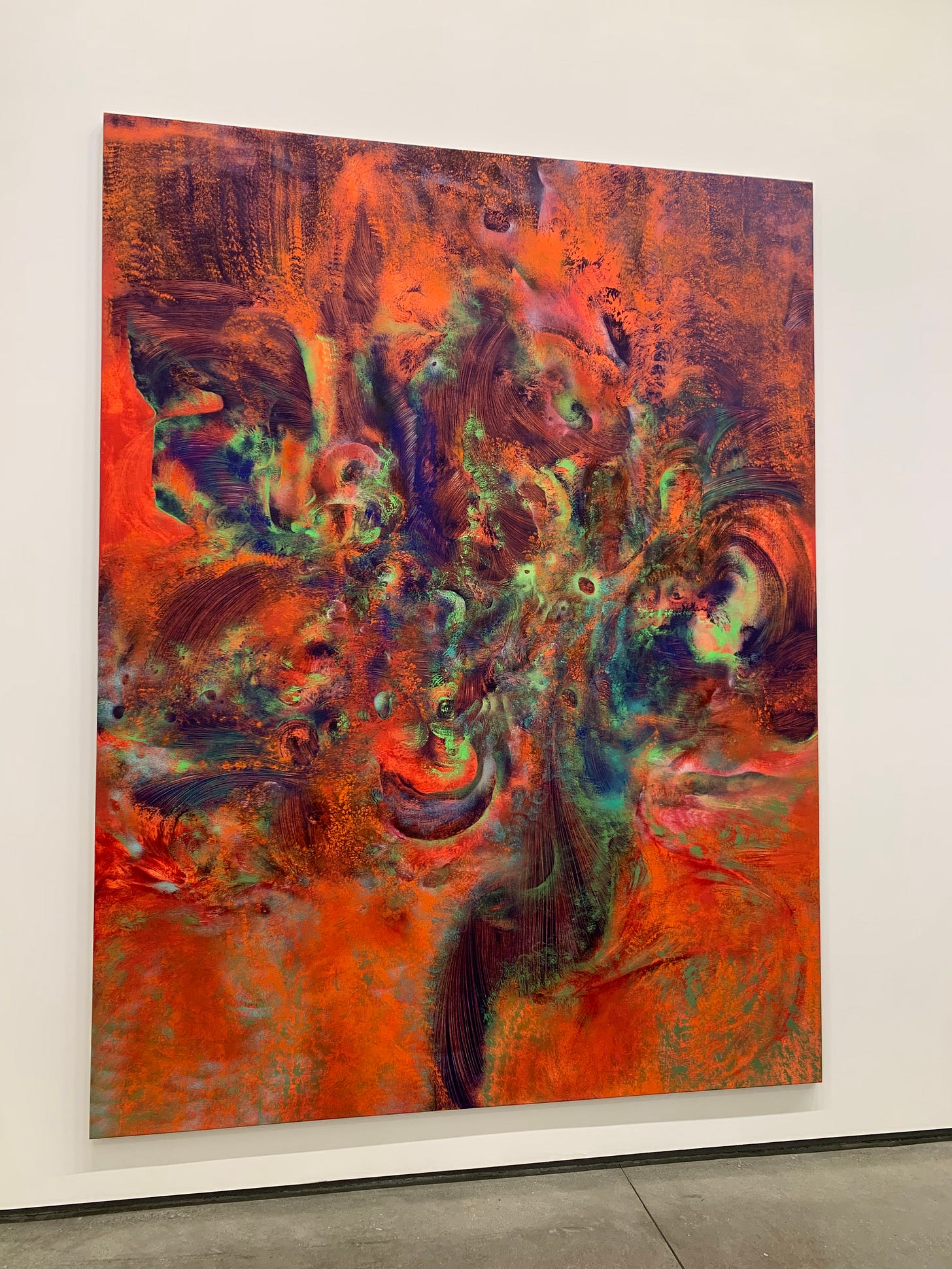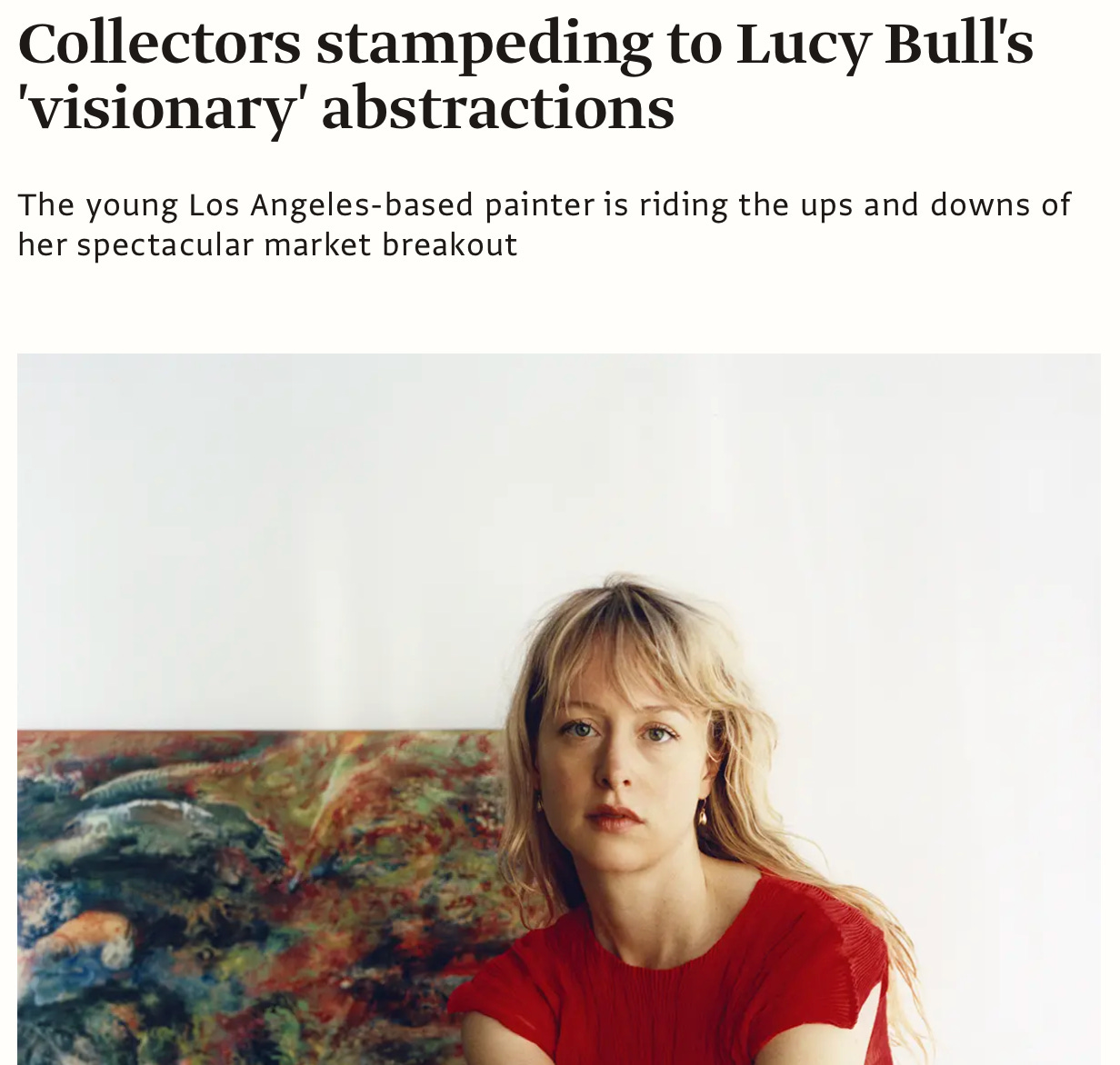Review: Lucy Bull at David Kordansky
Thinking about sponge painting, Sex and the City, and genius
I hadn’t heard of Lucy Bull before I saw her massive solo show at David Kordansky Gallery last weekend. It opened to a big, chicly dressed crowd, including the artist herself with a sheer baby blue dress. “Why is everyone so tall and model-ly?” my friend wondered aloud as we wandered around the front gallery. This was in contrast to the shorter, older and more diverse crowd in the back gallery hanging around the David Altmejd show.
Since seeing the show I have read that Bull’s paintings have hit the market hard, selling for over six figures. Even Bull herself was quoted as saying it was important to her to fight the feeling of making a commodity, given the flipping of her early paintings All this is to say, her paintings are so hot right now.
Without knowing any of this, other than the deductions one can make from a well-attended solo show at Kordansky, I was struck by the first impression of the dynamic, psychedelic paintings online and also the title of the show, Ash Tree. Having recently made a show inspired by an oak tree I felt a kinship to this energetic frequency that a number of artists seem to be tapping into right now: trees! What do they have to tell us?
Bull’s paintings capture the wild freneticism of nature, and the energetic swirling of death and rebirth, rather than a literal depiction of landscape. It’s inspiring to see someone lose the thread of representation while capturing the essence of a something real like a wave, a cloud, or a giant sinkhole as it is opening up. I felt inspired by her openness and her ability to suggest rather than describe. Although I wish there was more explanation as to the meaning of the title, and with it presumably more woo woo content about the glory of trees. (Maybe I’m projecting.)
The work from afar is compelling and dynamic. You can feel the movement and the layering are laid down with an earnest affection for the craft. I was drawn in because of the all the details.
There were, however, some buts. Up close, I was disappointed with her surfaces. They refuse any of the lushness of the oil paint, opting instead for matte layers. The paint handling bulldozes most traditional forms of mark-making with what looks like sponge-painting splats, scrapes (made with decommissioned paint brushes) and what might be air brush with oil. That the marks eschew tradition is not a negative, but the recall of kitsch painting tropes made me pause. I love me some good tourist paintings and grew up watching Bob Ross paint trees, but something about the top layer of brush work felt at times shoddy and unintegrated.
And then there’s the palette with a hospital-wall-lemon-yellow, what Frank Stella might have described as a cheap-looking red, a finger-paint primary blue and a San Francisco Giants orange that actually started to make me angry. Ultimately it was the garish palette that made me wonder whether I liked the work at all. How could I have been so wrong? This back and forth between liking and not liking the work continued throughout our walkthrough of the exhibition.
But that brings up another question, does liking the work really matter? It might matter to me with regards to whether I might purchase one of her works for my home, which I cannot do because they are both out of my price range and my social status as a collector.
But this tension between liking and being repelled by elements of the work made me want to write about them. Despite the dissonance, the paintings still edge their way towards some form of harmony, or at least complicity. They are nuanced in their layering and have a complexity that few painters can handle well at their scale. Like them or not, Bull has skills.
Plus, it would be easy for critics to make misogynistic comments about Bull’s quick rise to success because of her age, her looks, or the coolness of the crowd she runs with. That, in fact, feels like the subtext of this morning’s review in The Art Newspaper “Collectors stampeding to Lucy Bull's 'visionary' abstractions.” The word “visionary” is referenced in the article as part of a quote from David Kordansky the first time he saw Bull’s work. In the mostly complimentary article about the artist, the headline offers up the word visionary in quotations as if to ask, is she actually a visionary or just a market trend?
What it also brings up for me, paired next to her high-femme headshot, is a similar feeling to the the infamous question mark on the Sex and The City’s New York Magazine cover that read “Single and Fabulous?” It throws the initial intent of the words into question.
It’s as if to say: She’s young(ish), pretty and blond. Could her work actually be genius, or do we reserve that for a different demographic?
I don’t know enough about Bull or her work to say whether she’s a true visionary - whatever that means- but I worry about headlines like this that undermine a woman artist’s ability to be paired with that word and taken at face value. (Maybe more women, like the ladies of the Poog podcast, need to just claim the word genius for themselves.)
Most of our tastes (in geniuses or not) are socially constructed anyway. In the book “Celine Dion's Let's Talk About Love: A Journey to the End of Taste (33 1/3),” the author Carl Wilson writes about how 99% of the world was obsessed with “My Heart Will Go On,” Dion’s song from the Titanic, for decades after the movie was released. Only the first-world overeducated class turned our noses up at its heart-feltedness.
We with masters degrees prefer things that activate our minds and our knowledge of canons and social norms so we can subvert them through irony. Although this book was written before the pandemic so I wonder if things have changed since then.
So what does it mean to align yourself with Lucy Bull and her work? For her well-clad peers, it might mean something different than the collectors vying for a chance to purchase one of her works. As a painter, to like her work it feels like I’m supporting an artist’s freedom to make big, weird paintings. I want to give props to someone who has invested some serious time and effort into the construction of their work. And as a woman, I want to support Bull because she’s sticking her neck out.
It’s scary out there, regardless of what you look like. Success in the art market means walking a tightrope that wobbles when you add in complicated factors like identity come in - age, gender, attractiveness, race and social status. Thinking about it all makes me feel like my relative anonymity is a gift.
Did you see her show or have you been following her work? What do you think?










Thanks for this wonderful review. I hadn't heard of Lucy, but I'm not on top of my art game right now. But maybe we don't use the term "genius" so much with women because we already know how smart we are? It's just in our nature to carve the path and not talk about it, because we are busy telling others, "Come this way." xo
Thanks for your thoughtful processing on that show! I saw her previous show at kordansky, and I didnt immediately like the colors. There’s something interesting going on in the painting, but I guess it’s some kind of Jolie-laid thing happening. When I saw how white and blond she was I was like ok that’s what artists are supposed to look like 🤣. I do think there are all kind of ppl making work that is interesting though, but this I guess it help to be in the right body? Complicated 👍 for sure!